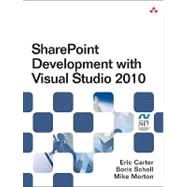
SharePoint 2010 Development with Visual Studio 2010
by Carter, Eric; Scholl, Boris; Jausovec, Peter-

This Item Qualifies for Free Shipping!*
*Excludes marketplace orders.
Rent Book
New Book
We're Sorry
Sold Out
Used Book
We're Sorry
Sold Out
eBook
We're Sorry
Not Available
How Marketplace Works:
- This item is offered by an independent seller and not shipped from our warehouse
- Item details like edition and cover design may differ from our description; see seller's comments before ordering.
- Sellers much confirm and ship within two business days; otherwise, the order will be cancelled and refunded.
- Marketplace purchases cannot be returned to eCampus.com. Contact the seller directly for inquiries; if no response within two days, contact customer service.
- Additional shipping costs apply to Marketplace purchases. Review shipping costs at checkout.
Summary
Author Biography
Boris Scholl, program manager on Microsoft’s Visual Studio team, works on Microsoft Visual Studio 2010 SharePoint developer tools. Previously, as senior technical product manager in Microsoft’s Office Server group, he focused on developer readiness and SharePoint integration with Project Server.
Peter Jausovec helped test and design the Microsoft Visual Studio 2010 SharePoint developer tools, focusing especially on SharePoint workflows.
Table of Contents
Tables xxxv
Foreword xxxix
Preface xli
Acknowledgments xliii
About the Authors xlv
Chapter 1: Introduction to SharePoint 1
What Is SharePoint Development? 1
Introduction to SharePoint Site Collections and Sites 7
The Central Administrative View of a SharePoint Server 74
A Visual Studio View of SharePoint: The Server Explorer 93
Conclusion 103
Chapter 2: Introduction to SharePoint Development in Visual Studio 2010 105
Creating a SharePoint Solution 105
Conclusion 152
Chapter 3: Introduction to the SharePoint Object Model 153
Introduction 153
The Disposable Pattern in SharePoint Development 157
Sandboxed Solutions 160
A Little Set Up 162
From the Top: Web Applications, Site Collections, and Sites 172
Working with Lists 194
Working with Queries 221
Working with Users 226
Other Important SharePoint Objects 227
Conclusion 229
Chapter 4: SharePoint Lists 231
Introduction to SharePoint Lists 231
Creating Lists 231
Conclusion 315
Chapter 5: SharePoint Event Receivers 317
Introduction to Event Receivers 317
Creating Event Receivers in Visual Studio 331
Creating Feature Event Receiver Projects 341
Deploying and Debugging Event Receiver Projects 347
Conclusion 358
Chapter 6: Working with Business Data 361
Introduction to Business Connectivity Services 361
Creating External Content Types Using SharePoint Designer 362
Creating External Content Types Using Visual Studio 384
Conclusion 455
Chapter 7: SharePoint Content Types 457
Introduction to Content Types 457
Content Types in Visual Studio 2010 470
Advanced Content Types 491
Conclusion 522
Chapter 8: SharePoint Workflow 525
Workflow Basics 525
Workflow Activities 528
SharePoint Workflows 536
Workflow Forms 552
Workflows in SharePoint Designer 562
Conclusion 578
Chapter 9: SharePoint Web Parts 579
Introduction to Web Parts 579
Web Part Fundamentals 580
Creating a Visual Web Part 581
Creating a Code-only Web Part (Sandboxed) 609
Creating a Silverlight Web Part 619
Web Part Connections 636
Configuration of Web Parts 643
Conclusion 654
Chapter 10: SharePoint Pages 655
Introduction to SharePoint Pages 655
SharePoint Architecture 655
Customizing and Developing SharePoint Pages 661
Conclusion 697
Chapter 11: Packaging and Deployment 699
The Basics and Beyond 699
SharePoint Features 699
SharePoint Solution Packaging 712
The SharePoint Project Structure in Visual Studio 721
Configurable Deployment 751
Conclusion 786
Appendix A: Preparing for SharePoint Development 787
Supported Operating Systems 787
Installing SharePoint 2010 788
Installing Visual Studio 2010 803
Installing SharePoint Designer 2010 807
Creating a Site Collection 809
Developer Dashboard 812
Conclusion 815
Index 817
An electronic version of this book is available through VitalSource.
This book is viewable on PC, Mac, iPhone, iPad, iPod Touch, and most smartphones.
By purchasing, you will be able to view this book online, as well as download it, for the chosen number of days.
Digital License
You are licensing a digital product for a set duration. Durations are set forth in the product description, with "Lifetime" typically meaning five (5) years of online access and permanent download to a supported device. All licenses are non-transferable.
More details can be found here.
A downloadable version of this book is available through the eCampus Reader or compatible Adobe readers.
Applications are available on iOS, Android, PC, Mac, and Windows Mobile platforms.
Please view the compatibility matrix prior to purchase.